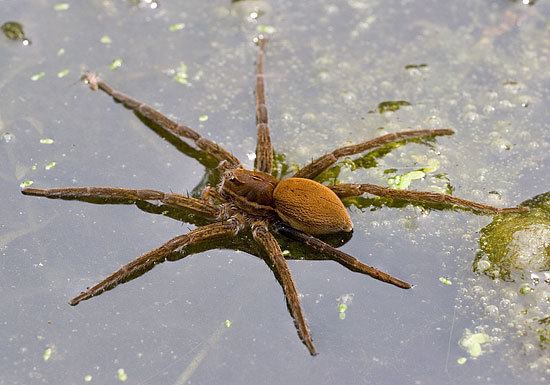Order Araneae | Family Pisauridae Scientific name Dolomedes triton Rank Species | |
 | ||
Similar Dolomedes, Nursery web spider, Dolomedes tenebrosus, Arachnid, Pisaurina mira | ||
Six spotted fishing spider male and female dolomedes triton
The six-spotted fishing spider, Dolomedes triton, is an arachnid from the nursery web spider family Pisauridae. This species is from the genus Dolomedes, the fishing spiders. This species of fishing spider is named after the mythological Greek god Triton who is the messenger of the big sea and the son of Poseidon. These spiders can be seen scampering along the water’s surface when a person walks by in which they are often referred to as dock spiders because they are often witnessed as they quickly vanish through the cracks of a boat dock.
Contents
- Six spotted fishing spider male and female dolomedes triton
- Six spotted fishing spider dolomedes triton 2
- Description
- Distribution and habitat
- Behavior and diet
- Reproduction
- References
Six spotted fishing spider dolomedes triton 2
Description

This spider can be identified by its large size and distinctive markings. They have eight eyes with good vision and the body is grey to brown. They have a white to a pale cream colored stripe running down each side of the cephalothorax. The abdomen has many light colored spots and also has light colored lines running down the sides of the abdomen. When this species is seen from below, there are six dark spots present on the bottom of the cephalothorax in which the common name is derived. Like many spiders, this species shows sexual dimorphism. The female is larger than the male. The female is about 60 millimeters (2.4 in) long including the legs; her body length is 15–20 mm (0.59–0.79 in) and the male's body is 9–13 mm (0.35–0.51 in) long. The juvenile spiders look similar to adults but are smaller and they go through a series of molts within their lifetime to grow and reach adult size.
Distribution and habitat

These spiders are native to the Western Hemisphere and can be found throughout the contiguous United States and southern Canada, more common east of the Rocky Mountains and Great Plains. They can also range into Mexico. They are semi-aquatic and live in wetland habitats such as ponds, lake shores, and they can also inhabit slow-moving streams. They can be found among vegetation, rocks and other structures near the water such as boat docks. They often dive underwater and grab onto a plant when frightened.
Behavior and diet
This species is diurnal which hunts during the day as it waits patiently for hours until depending on whether it is stimulated by prey. They are often seen with their legs sprawled out by the water while they are waiting for prey. These spiders eat insects, vertebrates, tadpoles and occasionally small fish. They hunt by the water’s surface in which they can walk on water and dive under up to 18 cm (7.1 in) to capture prey. Their good vision contributes to their success when diving to capture prey. They capture underwater prey as well as prey that fall on the water's surface or travels on water such as water striders.
Reproduction
Egg production can happen anytime between June to September and sometimes in April but this is not often. Breeding takes place when the male does his courtship ritual. This can be the end of the male's life because cannibalism does occur. After mating, the spherical egg sac is then produced. Before hatching, the female builds a "nursery web" over vegetation and guards it. The egg sac is placed among the leaves to help keep it concealed. After the offspring have hatched, they sit under her protection in the web until they are ready to disperse into the outside world. The offspring leave the web about a week after they hatch.
